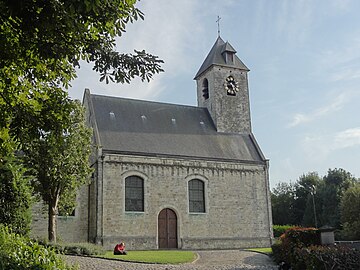Berchem-Sainte-Agathe
| |
|---|---|
 Berchem-Sainte-Agathe's Municipal Hall | |
| Coordinates: 50°52′N 04°18′E / 50.867°N 4.300°E | |
| Country | |
| Community | Flemish Community French Community |
| Region | Brussels-Capital |
| Arrondissement | Brussels-Capital |
| Government | |
| • Mayor | Christian Lamouline (LBR) |
| • Governing party/ies | LBR, PS-sp.a+, Ecolo-Groen |
| Area | |
• Total | 2.95 km2 (1.14 sq mi) |
| Population (2020-01-01)[1] | |
• Total | 25,502 |
| • Density | 8,600/km2 (22,000/sq mi) |
| Postal codes | 1082 |
| NIS code | 21003 |
| Area codes | 02 |
| Website | berchem.brussels/fr (in French) berchem.brussels/nl (in Dutch) |
Berchem-Sainte-Agathe (French, pronounced [bɛʁkɛm sɛ̃t aɡat]) or Sint-Agatha-Berchem (Dutch, pronounced [sɪnt aːˈɣaːtaː ˈbɛrxɛm] ⓘ), often simply called Berchem, is one of the 19 municipalities of the Brussels-Capital Region, Belgium. Located in the north-western part of the region, it is bordered by Ganshoren, Koekelberg, and Molenbeek-Saint-Jean, as well as the Flemish municipalities of Asse and Dilbeek. In common with all of Brussels' municipalities, it is legally bilingual (French–Dutch).
As of 1 January 2024[update], the municipality had a population of 25,787 inhabitants.[2] The total area is 2.95 km2 (1.14 sq mi), which gives a population density of 8,741/km2 (22,640/sq mi).[2] The municipality is known for its calm and peaceful character. It is said that Berchem is a "village in the city".
History
[edit]In the Middle Ages, Berchem-Sainte-Agathe was a modest village on the edge of Brussels. In 1795, it received the status of an autonomous municipality. In 1841, it separated from neighbouring Koekelberg, and in 1954, it became a part of the Brussels-Capital Region.
Main sights
[edit]Berchem-Sainte-Agathe has a rich cultural and architectural heritage.[3] Some of the main points of interest include:
- The former Church of St. Agatha, an old 12th-century Romanesque church. Completely renovated from 1972 to 1974, it is now deconsecrated and used for cultural ceremonies and celebrations.
- The Villa Marie-Mirande, an Art Nouveau house by the architect Victor Tinant.[4]
- The Cité Moderne, a housing project designed and built from 1922 to 1924 by the modernist architect Victor Bourgeois.[5]
-
Former Church of St. Agatha
-
Villa Marie-Mirande (1912)
-
Cité Moderne (1924)
Famous inhabitants
[edit]- David Lachterman (1934–1992), radio and television comedian and commentary expert
- Alexis Saelemaekers (born 1999), football player who has played as a winger for R.S.C. Anderlecht and A.C. Milan
- Françoise Schepmans (born 1960), politician and mayor of Molenbeek, was born there.
- Jean-Claude Van Damme (born 1960), actor and martial artist, was born there.
- Rudi Vervoort (born 1958), politician and Minister-President of the Brussels-Capital Region, was born there.
References
[edit]- ^ "Bevolking per gemeente op 1 januari 2020". Statbel.
- ^ a b "Berchem-Sainte-Agathe | IBSA". ibsa.brussels. Retrieved 10 January 2025.
- ^ "Berchem-Sainte-Agathe – Inventaire du patrimoine architectural". monument.heritage.brussels (in French). Retrieved 28 December 2021.
- ^ "Villa Marie-Mirande – Inventaire du patrimoine architectural". monument.heritage.brussels (in French). Retrieved 28 December 2021.
- ^ "Cité Moderne – Inventaire du patrimoine architectural". monument.heritage.brussels (in French). Retrieved 28 December 2021.
External links
[edit] Media related to Berchem-Sainte-Agathe at Wikimedia Commons
Media related to Berchem-Sainte-Agathe at Wikimedia Commons








